Varied difficulty levels in AP Inter 1st Year Zoology Model Papers Set 2 cater to students with diverse academic strengths and challenges.
AP Inter 1st Year Zoology Model Paper Set 2 with Solutions
Time : 3 Hours
Max. Marks: 60
Instructions to Candidate:
- Answer all the questions of Section A, Answer any Six questions in Section ‘B and answer any two questions in Section ‘C’.
- In Section ‘A’, questions from Sr. Nos. 1 to 10 are of Very Short Answer 1rpe. Each question carries two marks. Every answer may be limited to 5 lines. Answer all these questions at one place in the same order.
- In Section ‘B’, questions from Sr. Nos. 11 to 18 are of Short Answer Type. Each question carries four marks. Every answer may be limited to 20 lines.
- In Section C’, questions from Sr.Nos. 19 to 21 are of Long Answer Type. Each question carries eight marks. Every answer may be limited to 60 lines.
- Draw labelled diagrams wherever necessary in Section ‘B’ and ‘C’.
Section – A
(10 × 2 = 20)
Note: Answer all the questions in 5 lines.
Question 1.
What is trinominal nomenclature? Give an example.
Answer:
The trinominal nomenclature is the extension of the binominal system of nomenclature. It is permits the designation of subspecies with a three worded name called ‘trinomen’. Ex: Homo Sapiens Sapiens, Corvus splendens splendens.
Question 2.
What is cephalisation? How is it useful to its possessors?
Answer:
Cephalisation: The concentration of nerve (Brain) and sensory cells at the anterior end of the body is called as cephalisation. As a result of cephalisation. these animals can sense the new environment and move efficiently than the other animals in seeking food, locating matter and in avoiding from predators.
Question 3.
Distinguish between tendon and a ligament.
Answer:
Tendons are the collagen fibres tissue of dence regular connective tissue which attach the skeletal muscles to bones.
Ligaments are ako the collagen fibres tissue of dence regular connective tissue which attach bones to other bones.
Question 4.
Define Osteon.
Answer:
In compact bone structure, a haversin canal and the surrounding lamellae and Iacunae are collectively called a Haversin system, or Osteon.
![]()
Question 5.
What are the functions of the canal system of sponges?
Answer:
The functions of canal system of sponge àre gathering of food, respiratory exchange of gases and removal of wastes.
Question 6.
What are the Jacobson’s organs? What is their function?
Answer:
Jacobson’s organs are the specialized olfactory structures are highly developed in lizards and snakes.
Question 7.
Distinguish between proter and opisthe.
Answer:
During transverse binary fission in Paramecium two daughter individuals are formed. The anterior one is called proter and the
posterior is called opisthe.
Question 8.
Define conjugation with reference to ciliates. Give two examples.
Answer:
Conjugation is a temporary union between two senile ciliates that belong to two different meeting types’ for the exchange of nuclear material and its reorganization – Wichterman Ex: Paramecium and vorticella.
Question 9.
A person is suffering from bowel irregularity, abdominal pain, blood and mucus in stools etc. Based on these symptoms, name the disease and its causative organism.
Answer:
- Diesease is Amoebiasis
- Causative agent is Trophozite of “Entamoeba histolytic”.
Question 10.
What is biological magnification?
Answer:
An increase in the concentration of the pollutant (or) toxicant at successive trophic levels in an aquatic food chain is called ‘Bio-magnification’.
Section – B
(6 x 4 = 24)
Note: Answer any six questions, each in 20 lines.
Question 11.
Define species. Explain the various aspects of ‘species’.
Answer:
Species: Species is the ‘basic unit of classification, Species is a Latin word meaning ‘kind’ or ‘appearance’. John Ray in his book Historia Generalis Piantarum’, used the term ‘species’ and described it on the basis of common descent (origin from common ancestors) as a group of morphologically similar organisms. Linnaeus considered species, in his book ‘Systema Naturae’, as the basic unit of classification. Buffon, in his book ‘Natural History’, proposed the idea of evolution of species which is the foundation for the biological concept of evolution.
This biological concept of species (dynamic nature of species) became more popular with the publication of the book “The Origin of Species” by Charles Darwin. Buffon’s biological concept of species explains that species is an interbreeding group of similar individuals sharing the common ‘gene pool’ and producing fertile offspring. Species is considered as a group of individuals which are:
- Reproductively isolated from the individuals of other species – a breeding unit.
- Sharing the same ecological niche – an ecological unit.
- Showing similarity in the karyotype – a genetic unit.
- Having similar structure and functional characteristics – an evolutionary unit.
![]()
Question 12.
Describe the structure of cardiac muscle.
Answer:
Cardiac muscle: The cardiac muscle is striated like the skeletal muscle (shows sarcomeres) Cardiac muscle is found in the “myocardium” of the heart of vertebrates. The cardiac muscle cells or the ‘myocardial cells are short, cylindrical, mono-nucleate or binucleate cells whose ends branch and form junctions with other cardiac muscle cells. Each myocardial cells is joined to adjacent myocardial cells by ‘electrical synapses’ or ‘gap junctions’. They permit ‘electrical impulses’ to be conducted along the long axis of the cardiac muscle fibre. The dark lines across cardiac muscle are called ‘intercalated discs’ (IDs). These discs are highly characteristic of the cardiac muscle.
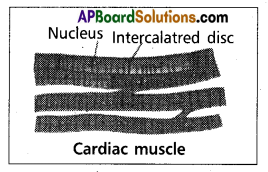
Question 13.
What are the salient features of Echinoids?
Answer:
- It includes sea urchins, heart urchins, sand dollars etc. The body is avoid or discoidal and covered by movable spines.
- Arms are absent, tube feet are arranged in five bands and bear suckers.
- Ossicles of the body unity to form a rigid test or corona or case.
- Pedicellaria are “three jawed”.
- Anus and madreporite are aboral in position.
- Ambulacral grooves are closed.
- A complex five-jawed masticatory apparatus called Aristotle’s lantern is present just inside the mouth. It is absent in heart urchins.
- Life history includes larval form called echinopluteus.
- Specialized gills called peristomial gills occurs in sea urchins. Eg: Salmacis (sea urchins), Echino Cardium (heart orchids) clypeastoer (cake urchins).
Question 14.
Compare and contrast cartilaginous and bony fishes.
Answer:
| Cartilaginous fishes | Bony fishes |
| 1. These are marine farms. | 1. These are live in all kinds of aquatic habitats. |
| 2. Endoskeleton made by cartilaginous. | 2. Endoskeleton made by bone. |
| 3. Body covered by placoid scales. | 3. Body covered by cosmoid, ganoid, cycloid or ctenoid scales. |
| 4. Caudal fin is heterocercal. | 4. Caudal fin s homocercal. |
| 5. Operculum absent. | 5. Operculum present. |
| 6. Air bladder absent. | 6. Air baldder present. |
| 7. Gills are lamelliform and are five to seven in each side. | 7. Gills are filamentous and are four in each side. |
| 8. These are ureotelic. Ex : Scoliodon, Pristic, Torpedo |
8. These are mostly ammonotelic. Ex: Catla, Labeo, Exocetus, Hippocampus. |
Question 15.
Give an account of pseudopodia.
Answer:
Locomotion in protozoans is performed by cellular extensions such as pseudopodia are found in rhizopods organisms. The pseudopodia are temporary extensions of cytoplasm that develop in the direction of the movement. These temporary structures are useful to move on Specutratum as our legs do, hence the name pseudopodia There dre four kinds of pseudopodia in protozoans.

- Lobopodia: blunt + finger-like Pseudopodia. Ex: Amoeba, Entamoeba.
- Filopodia : fiber like pseudopodia contain ectoplasm. Ex: Euglypha
- Reticulopodia : net like pseudopodia. Ex : Elphidium.
- Axopodia or heliopodia: Sun ray-like pseudopodia. Ex: Actinophys.
Question 16.
Prevention is better than cure’ justify with regard to TDA abuse.
Answer:
The age-old edage of prevention is better than cure holds true here also. Some of the measures useful for prevention and control of TDA abuse among the adolescents are:
- Avoid undue parental pressure: Every child has his/her own choice. Capacity and personality. The parents should
not force their children to perform beyond their capacity by comparing them with others in studied, games etc. - Responsibility of parents and teachers: They should look for the danger signs and counsel such students who are likely to get into the trap’.
- Seeking help from peers: If peers find someone abusing drugs or alcohol immediately it should be brought to the notice of their parents or teachers so that they can guide them appropriately.
- Education and counselling: Educating and counselling the children to face problems, stress and failures as a part of life.
- Seeking professional and medical help: A lot of help is available in the form of highly qualified psychologists, psychiatrists and de-addiction and rehabilitation programmers.
![]()
Question 17.
Draw a neat labelled diagram of the salivary apparatus of cockroach.
Answer:
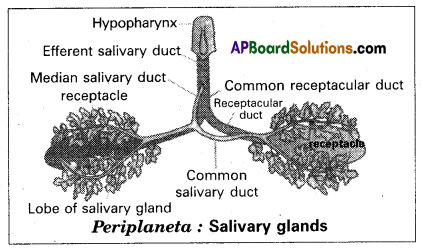
Question 18.
Write a short note on the various trophic levels in a typical ecosystem.
Answer:
An ecosystem is a functional unit of nature, where living organisms interact among themselves and also with the surrounding physical environment. Ecosystem varies greatly in size from a small pond to a large forest or sea. Many ecologists regard the entire biosphere as a global ecosystem as composite of all local ecosystems on earth.
Since this system is too big and complex to be studied at one time. It is convenient to devide it into two basic categories, namely natural and artificial. The natural ecosystems include aquatic ecosystems of water and terrestrial ecosystems of the land. Both type of natural and artificial ecosystems have several sub divisions.
The natural ecosystem :
These are naturally occurring ecosystems and there is no role of humans in the formation of such types of ecosystems. These are categorized mainly into two types, Aquatic and terrestrial ecosystems. These are man-made ecosystems such as agricultural or agro-ecosystems. They include cropland ecosystems, aquaculture ponds and aquaria.

Section – C
(2 x 8 = 16)
Note: Answer any two questions, each in 60 lines.
Question 19.
Describe the structure and life cycle of Ascaris lumbricoides with the help of a neat labelled diagram.
Answer:
Ascaris lumbricoids is commonly called the common roundworm. It lives in the small intestine of man, more frequently in children. It is cosmopolitan in distribution. Mode of infection is through contaminated food and water. Infective stage is the embryonated egg with the 2nd stage rhabditiform larva.
Structure: Sexes are separate and the sexual dimorphism is distinct. In both males and females. The body is elongated and cylindrical. Mouth is present at the extreme anterior end and is surrounded by three chitinous lips close to the mouth mid-ventrally there is a small aperture called excretory pore.
Male: It has a curved posterior end which is considered the tail. The posterior end possesses a cloacal aperture and a pair of equal sized chitinous pineal spicules or pineal setae which serve to transfer the sperms during copulation.
Female: It has a straight posterior end the tail. The female genital pore or vulva ¡s present mid-ventrally at about one-third the length from mouth. The anus is present a little in front of the tail end.
Life history: Copulation takes place in the small intestine of man. After copulation, the female releases approximately two lakh eggs per day. Each egg is surrounded by a protein coat with rippled surface. Hence the eggs of Ascaris are described as mammillated eggs. The protein coat is followed by a chitinous shell and a lipid layer internally.
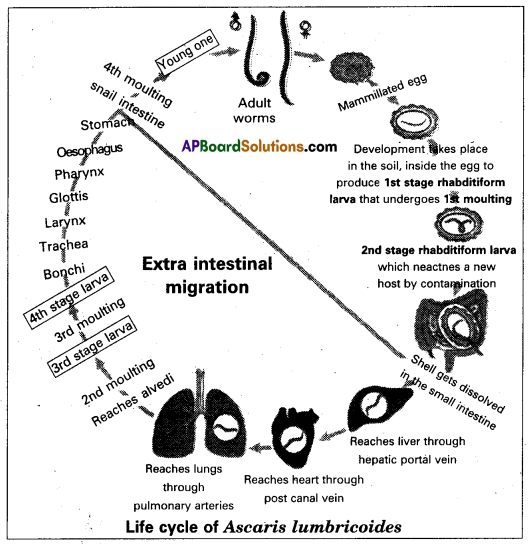
These eggs come out along with faecal matter. In the moist soil, development takes place inside the egg so that the 1-stage rhabditiform larva is producted. It undergoes the 1st moulting and becomes the 2’ stage rhabditiform larva which is considered the stage infective to man. They reach the alimentary canal of man through contaminated food and water.
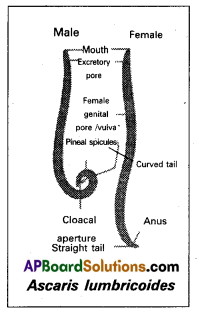
In the small intestine, the shell gets dissolved so that the 2nd stage larva is released. Now it undergoes extra intestinal migration. First, it reaches the liver through the hepatic portal vein. From there it reaches the heart through the post caval vein. It goes to the lungs through the pulmonary arteries. In the alveoli of lungs it undergoes the 2nd moulting to produce the 3 stage larva. It undergoes the 3 moulting so that the 4th stage larva is produced in the alveoli only. It leaves the alveoli and reaches the small intestine again through bronchi, trachea, larynx, glottis, pharynx, oesophagus and stomach. In the small intestine. It undergoes the 4th and final mou Iting to become a young one which attains sexual maturity within 8 to 10 weeks.

![]()
Question 20.
Describe the blood circulatory system of Periplaneta and draw a neat and labelled diagram of it.
Answer:
The circulatory system helps in the transportation of digested food, hormones etc., from one part to another in the body. Periplaneta has an open type of circulatory system as the blood or haemolymph, flows freely within the body cavity or haemocoel, Blood vessels are poorly developed and open into spaces. Visceral organs located in the haemocoel are bathed in the blood. The three main parts associated with the blood circulatory system of Periplaneta are the haemocoel, heart and blood.
Haemocoel: The haemocoel of cockroaches is divided into three sinuses by two muscular, horizontal membranes called dorsal diaphragm or pericardial septum and ventral diaphragm. Both the diaphragms have pores. There ¡s a series of paired triangular muscles called alary muscles. Every segment has one pair of these muscles situated on the lateral sides of the body. These are attached to the pericardial septum by their broad bases and to the terga by their broad bases and to the terga by their pointed ends or apices.
The three sinuses of the haemocoel are known as pericardial haemocoel or the dorsal sinus, the perivisceral haemocoel or the middle sinus and sternal haemocoel or ventral sinus or perineural sinus. The middle sinus is very large as it contains most of the viscera. The dorsal and ventral sinuses are small as they have only heart and nerve cords, respectively.
Heart: The heart lies in the pericardial haemocoel or dorsal sinus. It is a long muscular, contractile tube found a long the mid-dorsal line, beneath the terga of the thorax and abdomen.
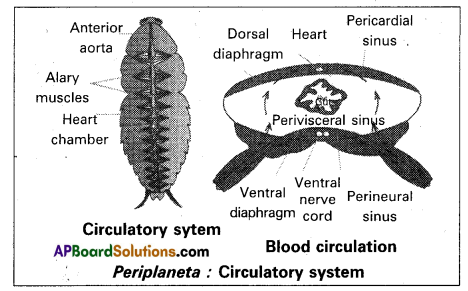
It consists of 13 chambers. Every chamber opens into the other present in front of it. Three of the thirteen chambers are situated in the thorax and ten in the abdomen. Its posterior end is closed while the anterior end is continued forward as the anterior aorta. At the posterior side of each chamber, except the last there is a pair of small apertures called ‘Ostia one on each side. Ostia have valves which allow the blood to pass only into the heart from the dorsal sinus.
Blood: The blood of Periplaneta is colourless and is called haemolymph. It consists of a fluid called plasma and free blood corpuscles or haemocytes, which are phagocytic. The phagocytic, the phagocytes are large in size and can ‘ingest’ foreign particles such as bacteria. There is no respiratory pigment in the blood and so it plays no major role in respiration.
Question 21.
Describe lake as an ecosystem giving examples for various zones and biotic components of it.
Answer:
Deepwater lakes contain three distinct zones namely
- Littoral zone,
- limnetic zone and
- profundal zone.
i) Littoral Zone: It is the shallow part of the lake closer to the shore. Light penetrates up to the bottom. It is ‘euphotic’ (having good light) has rich vegetation and higher rate of photosynthesis, hence rich in oxygen.
ii) Limnetic Zone: It is the open water zone away from the shore. It extends up to the effective light penetration level, vertically. The imaginary Line that separates the limnetic zone from the profundal zone is known as the ‘zone of compensation/compensation point’ light compensation level. It is the zone of effective light penetration. Here the rate of photosynthesis is equal to the rate of respiration. The limnetic zone has no contact with the bottom of the lake.
iii) Profundal Zone: It is the deep water area present below the limnetic zone and beyond the depth of effective light penetration. Light is absent. Photosynthetic organisms are absent and so the water is poor in oxygen content. It includes mostly the anaerobic organisms which feed on detritus.

The organisms living in lentic habitats are classified into pedonic forms. Which live at the bottom of the lake and those living in the open waters of lakes, away from the shore vegetation are known as limnetic forms.
Biota (animal and plant life of a particular region) of the littoral zone: Littoral zone is rich with pedonic flora (especially up to the depth of the effective light penetration). At the shore, proper emergent vegetation ¡s abundant with firmly fixed roots in the bottom of the lake and shoots and leaves are exposed above the level of water.
These are amphibious plants. Certain emergent rooted plants of littoral zone are the cattails (Typha) bulrushes (scripus) arrowheads (Sagittarius). Slightly deeper are the rooted plants with floating leaves, such as the water lilies (Nymphaea) Nelumbo, Trapa etc., still deeper are the submerged plants such as Hydrilla – Chasa, Potamogeton etc. The free-floating vegetation includes pista, wolfie, Lemna (duckweed), Azolla, Eichhornia etc.
The phytoplankton of the littoral zone composed of diatoms (coscinodiscus, Nitzschia etc) green algae (volvax spirogyra etc), euglenoids (Eu glena, phacus etc) and dinoflagellates (Gymnodinium, cystodinium etc.).
Animals the consumers of the littoral zone, are abundant in this zone of the lake, these are categorized into zooplankton, neuston, nekton, periphyton and benthos. The Zoo-plankton of the littoral zone consists of ‘water fleas’ such as Daphnia, rotizers and ostracods.
The animals living at the air-water interface constitute the neuston. They are of two types. The epineuston and hyponeuston. Water striders (Gerris), beetles, water bugs (Dineustes) from the epineustan/supra neuston and the hydro neustan/infra neuston includes the larvae of mosquitoes.
The animals such as fishes amphibians, water-snakes, terrapins, insects like water scorpions (Ranatra) back swimmers (Notonecta), driving beetley (Dytiscus), capable of swimming constitute the nekton.
The animals that are attached to/creeping on the aquatic plants, such as the ‘water snails’ nymphs of insects, bryozoans, turbell Arians, hydras etc., constitute the periphyton.
The animals that rest on or move on the bottom of the lake constitute the benthos. e.g. : red annelids, chironomid, larvae, crayfishes, some iso pods amphipods clams etc.
Biota of the Limnetic Zone: Limnetic zone is the largest zone of a lake. It is the region of rapid variations of the level of the water, temperature, oxygen availability, etc., from time to time. The limnetic zone has autotrophs (photosynthetic plants) in abundance. The chief autotrophs of this region are the phytoplankton such as the euglenoids, diatoms, cyanobacteria, dinoflagellates and green algae. The consumers of the limnetic zone are the zooplanktonic organisms such as the copepods, Fisher frogs, water snakes etc., form the limnetic nekton.
Biota of the Profundal Zone: It includes the organisms such as deco mposers (bacteria), chironomid larvae, Chaoborus (phantom larva), red annelids, clams etc., that are capable of living in low oxygen levels. The decomposers of this zone decompose the dead plants and animals and release nutrients which are used by the biotic communities of both littoral and limnetic zones.
The lake ecosystem performs all the functions of any ecosystem and of the biosphere as a whole. i.e., conversation of inorganic substances into organic material, with the help of the radiant solar energy by the autotrophs, consumption of the autotrophs by the heterotrophs; decomposition and mineralization of the dead matter to release them back for reuse by the autotrophs (recycling of minerals).